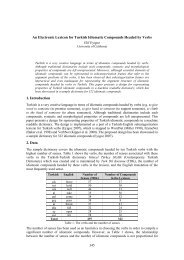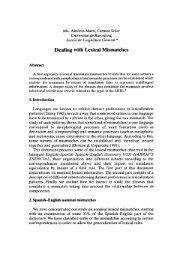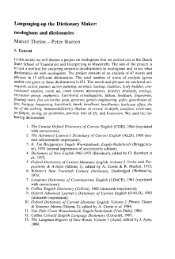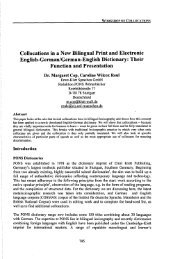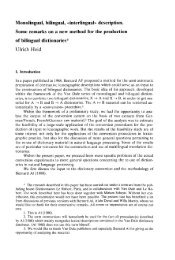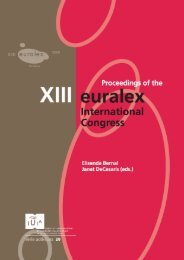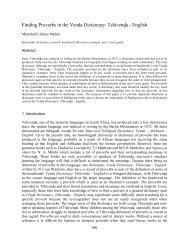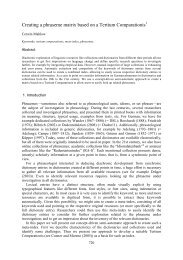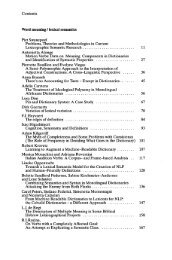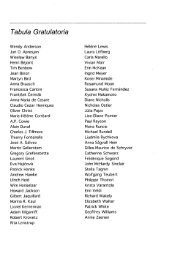Lexicon Creator: A Tool for Building Lexicons for Proofing ... - Euralex
Lexicon Creator: A Tool for Building Lexicons for Proofing ... - Euralex
Lexicon Creator: A Tool for Building Lexicons for Proofing ... - Euralex
Create successful ePaper yourself
Turn your PDF publications into a flip-book with our unique Google optimized e-Paper software.
<strong>Lexicon</strong> <strong>Creator</strong>: A <strong>Tool</strong> <strong>for</strong> <strong>Building</strong> <strong>Lexicon</strong>s<br />
<strong>for</strong> <strong>Proofing</strong> <strong>Tool</strong>s and Search Technologies<br />
Thierry Fontenelle<br />
Nick Cipollone<br />
Mike Daniels<br />
Ian Johnson<br />
Microsoft Corporation<br />
In this paper, we describe <strong>Lexicon</strong> <strong>Creator</strong>, a tool designed to help developers produce<br />
lexical data <strong>for</strong> its use in a variety of linguistic applications such as spell-checkers, wordbreakers,<br />
thesauri, etc. The tool enables developers to work on existing wordlists derived<br />
either directly from corpora or from previously created wordlist data. The key feature of<br />
the tool is that it enables linguists to rapidly create the morphological rules that are<br />
necessary to generate all the inflected <strong>for</strong>ms of a given item. In many languages, a given<br />
word may have many <strong>for</strong>ms, each distinguished by different endings attached to the stem of<br />
the word. A language like English is rather simple, morphologically-the verb walk only has<br />
the following <strong>for</strong>ms: walk, walks, walked, walking, while other languages may have a<br />
number of different <strong>for</strong>ms <strong>for</strong> a word. Yet, it is essential to create lexicons that can<br />
recognize and generate all the inflected <strong>for</strong>ms of a given word, especially <strong>for</strong> applications<br />
such as spell-checkers-where overgeneration should be avoided, thesauri, grammar<br />
checkers, morphological analyzers/generators, speech recognition, and handwriting<br />
recognizers. It would be extremely time-consuming to code each of these <strong>for</strong>ms<br />
individually, so it is necessary to develop this data more efficiently. <strong>Lexicon</strong> <strong>Creator</strong><br />
allows linguists to classify these variations of the same word into templates, or<br />
morphological classes, which allow the automatic generation of all valid <strong>for</strong>ms of a<br />
word. Once the templates describing the a<strong>for</strong>ementioned variations have been defined,<br />
the data-coding task consists of assigning an input word to the correct template and<br />
checking that the <strong>for</strong>ms generated automatically are valid. The article will also focus on<br />
the additional types of linguistic in<strong>for</strong>mation which can be attached to words, depending<br />
on the intended application that will use the resulting full-<strong>for</strong>m lexicon.<br />
Introduction<br />
Applications such as spell-checkers, morphological analyzers or handwriting recognizers rely<br />
upon large lexicons with varying degrees of linguistic in<strong>for</strong>mation attached to the lexical items.<br />
In the case of spell-checkers or handwriting recognizers, one straight<strong>for</strong>ward way of<br />
approaching the lexicon issue is to say that a list of all valid word <strong>for</strong>ms is sufficient, which<br />
means that the lexicon should be as large as possible and should include all the word <strong>for</strong>ms one<br />
would expect the tool to verify (i.e. accept and possibly suggest, in the case of a spell-checker).<br />
While this may be true <strong>for</strong> many languages in theory, it says nothing about how this list of<br />
possible word <strong>for</strong>ms should be created. Knowledge of the morphological rules of a language is<br />
of course essential and care should be exercised when implementing these rules to avoid the<br />
overrecognition issues which are commonly found in NLP applications geared towards the<br />
analysis of unknown words. Fontenelle (2004) shows how careful the creators of spellers should<br />
be to avoid producing analyses <strong>for</strong> words which are spelling mistakes (e.g. conu being<br />
potentially analyzed as co+nu “co-naked” when the intended French word is connu, or transfer<br />
being potentially analyzed as trans+fer “transiron” when the correct spelling in French should<br />
be transfert). One solution we adopted <strong>for</strong> building the lexicons that underlie spell-checking<br />
technology and stemmers used in some search engines is to store lemmas together with their<br />
inflected <strong>for</strong>ms in our lexicons. This means that we need to be able to generate all and only the<br />
359
T. Fontenelle, N. Cipollone, M. Daniels, I. Johnson<br />
possible correct <strong>for</strong>ms, which requires in-depth descriptions of the morphological rules of a<br />
language.<br />
<strong>Building</strong> full-<strong>for</strong>m lexicons<br />
Compared to many other languages, English has a relatively impoverished morphological<br />
system. Nouns typically <strong>for</strong>m their plurals by adding -s or -es (after a sibilant) and have a nearly<br />
non-existent case system, the genitive being the only remnant of such a system (the president’s<br />
decision). This means that a given noun normally has 4 distinct <strong>for</strong>ms (e.g. dog, dogs, dog’s,<br />
dogs’). Verbs traditionally have 4 or 5 distinct <strong>for</strong>ms (work, works, worked, working; eat, eats,<br />
eating, ate, eaten). It would be extremely time-consuming to list all these <strong>for</strong>ms and add them to<br />
the lexicon individually, which is why we have developed a tool, <strong>Lexicon</strong> <strong>Creator</strong>, that enables<br />
linguists to author the morphological rules of a given language and facilitates the generation of<br />
inflected <strong>for</strong>ms. <strong>Lexicon</strong> <strong>Creator</strong> allows linguists to classify variations of a given word into<br />
templates, which correspond to morphological classes. Once the templates have been defined,<br />
the data-coding process basically consists of associating a word to its correct template and<br />
checking that all the possible inflected <strong>for</strong>ms of this word are generated (and only these<br />
inflected <strong>for</strong>ms, if one wants to avoid overgeneration). If a template includes the rules that are<br />
necessary to create the distinct <strong>for</strong>ms of a verb like work (infinitive = base <strong>for</strong>m; 3 rd person<br />
singular = +s; past tense = +ed; present participle/gerund = +ing), it will then be sufficient to<br />
associate other verbs such as walk, talk, bark, crack… with the same template to automatically<br />
add inflected <strong>for</strong>ms such as walks, talked, barking or cracked to the lexicon, without having to<br />
manually list them.<br />
Authoring morphological rules<br />
<strong>Lexicon</strong> <strong>Creator</strong> provides a powerful authoring environment which enables the linguist to create<br />
sometimes very complex morphological rules, using regular expression patterns,<br />
character/string classes and functions which have made it possible to describe the inflectional<br />
system of over 40 languages, including Romance, Germanic, Scandinavian, Uralic, Semitic,<br />
African, Indic and Asian languages. Phenomena like gemination (En. big – bigger), vowel<br />
changes (Ge. Buch – Bücher), stem changes (Fr. venir – viens) can be expressed easily via<br />
functions which encode trans<strong>for</strong>mations consisting of patterns and replacements. Gemination of<br />
final consonants can be expressed as follows, <strong>for</strong> instance:<br />
Patterns appear to the left of the arrow and replacements appear to the right of the arrow.<br />
GeminateCons (e.g. travel travell):<br />
(.*)() (1)(2)(2)<br />
This function matches zero or more characters (.*) followed by a vowel and a consonant and<br />
returns the same initial sequence of characters followed by the same vowel followed by two<br />
occurrences of the consonant. has been defined as a string class consisting of all<br />
vowels. has been defined as a string class consisting of all geminating consonants<br />
(b, d, g, k, l, m, n, p, r, t).<br />
Once such a function has been defined, it can be used in writing the rules that can generate the<br />
inflected <strong>for</strong>ms that undergo gemination <strong>for</strong> a class of verbs that includes stop, blog, dot, flip…<br />
A rule which <strong>for</strong>ms the past tense would then look like this:<br />
(GeminateCons)ed<br />
which can be read as follows: the GeminateCons function applies to Stem #1 and the suffix “ed”<br />
is added to the output of that function. Assuming that the stem is stop, the intermediate<br />
geminated <strong>for</strong>m will be stopp and the final inflected <strong>for</strong>m generated by this rule will be stopped.<br />
The same function would be useful to create rules <strong>for</strong> adjectives that double their final<br />
consonant (big – bigger, dim – dimmer…). It will be used in English but also in languages like<br />
Dutch, where gemination is also fairly common (dun – dunner; kat – katten). It should also be<br />
noted that there need to be (at least) two distinct templates, one <strong>for</strong> words that cannot undergo<br />
360
Section 1. Computational Lexicography and Lexicology<br />
gemination, and one <strong>for</strong> items that do (compare stop and develop, the <strong>for</strong>mer undergoing<br />
gemination in stopped, unlike the latter – developed).<br />
Adding entries to the lexicon<br />
In our context, lexical acquisition means adding words to the lexicon, which boils down to<br />
assigning a template to a lexical entry so that all the correct inflected <strong>for</strong>ms can be generated<br />
and stored in the lexicon. The lexicographer using <strong>Lexicon</strong> <strong>Creator</strong> can use a word list as a<br />
source of lexical data. Powerful sorting and filtering functionalities make it easy to target<br />
specific subsets of the word list or to sort it as a function of various criteria, <strong>for</strong> instance in<br />
increasing or decreasing order of frequency (if the list includes word <strong>for</strong>ms extracted from a<br />
large corpus with frequencies of occurrences). Because the ending of a word can traditionally be<br />
used as a clue to the morphological properties of a lexical item, it is also possible to sort the<br />
word <strong>for</strong>ms in reverse alphabetical order, which groups words that have a common ending. For<br />
instance, whisky and baby should be assigned to the same template since they both have a plural<br />
in –ies (whiskies, babies); similarly, easy and happy are similar insofar as they both have the<br />
same types of comparatives and superlatives (happier/happiest, easier/easiest). Words that share<br />
common morphological properties can be grouped together and bulk-imported via a dynamic<br />
user interface which guides the user through a series of menus to choose the appropriate<br />
template classes, templates and inflected <strong>for</strong>m slot names to which these words should be<br />
assigned.<br />
An “Analyses” window presents the list of possible ways of analyzing a given word <strong>for</strong>m which<br />
are ordered according to how closely the word matches a particular pattern (the highest ranking<br />
match appearing at the top of the list). This window helps pick the correct template. The choice<br />
can be complicated by the multiplicity of templates in a language, especially when that language<br />
is morphologically richer than English. The languages <strong>for</strong> which we have created template<br />
lexicons with <strong>Lexicon</strong> <strong>Creator</strong> typically have several dozen morphological classes <strong>for</strong> nouns,<br />
adjectives and verbs and it is not always easy to choose the correct template which will generate<br />
the correct inflected <strong>for</strong>ms of a given lemma. To facilitate the lexical acquisition process, the<br />
lexicographer can select multiple entries in the Word List panel, sort them and filter them<br />
according to various linguistic criteria and bulk-assign them to a given template when she is<br />
100% sure (see screenshot below). In addition to these powerful functionalities, the tool also<br />
includes interactive lexicon merging and comparison features, which make it possible to<br />
compare two versions of the same lexicon and to merge changes made by different users.<br />
Affix management via subtemplates<br />
Templates can be viewed as either highly structured entities or as flat tables. In order to capture<br />
morphological redundancies, templates can have an internal substructure which allows <strong>for</strong> the<br />
management of regular affixes attached to inflected <strong>for</strong>ms. Such substructures are intended to be<br />
used in languages where multiple, individually-separable affixes can attach to a single word in a<br />
“chain”. By representing each affix as a separate data structure, linguists can build up structured<br />
templates that encode all possible affix combinations without having to enter and maintain<br />
multiple copies of the same in<strong>for</strong>mation. Subtemplates can be embedded in the rules tree of a<br />
given template to specify how affixes are realized in different environments. In French, clitics -<br />
ci and -là are deictic locative adverbs corresponding to “here” and “over there” (cet ordinateurci<br />
“this computer here” vs. cet ordinateur-là “that computer over there”) that can be attached<br />
(with a hyphen) to singular and plural <strong>for</strong>ms of any noun. We can there<strong>for</strong>e define a general<br />
class of affixes <strong>for</strong> these deictic adverbs (subtemplates can also be used <strong>for</strong> non-hyphenated<br />
clitics, as in Spanish with dámelo “give it to me” or dame “give me”, <strong>for</strong> instance).<br />
361
<strong>Lexicon</strong> <strong>Creator</strong>’s panels<br />
T. Fontenelle, N. Cipollone, M. Daniels, I. Johnson<br />
<strong>Lexicon</strong> <strong>Creator</strong> has four main panels, as shown in the screenshot below:<br />
- Word List: this panel allows the lexicographer to load an external list of words (with<br />
optional frequencies) and view, sort and filter this list in a number of ways. The words<br />
from a corpus used as a source to populate our lexicons will typically be displayed and<br />
manipulated in this panel. Powerful filtering functionalities enable the lexicographer to<br />
quickly identify words which are or are not already in the lexicon, words which end in a<br />
given suffix, and even words which can be analyzed as valid compounds by the<br />
dynamic compounding module described below.<br />
- Analyses: When a word is selected from the word list, it is automatically copied to the<br />
“current word” textbox in the toolbar. The system then generates a list of possible<br />
templates to which this word can be assigned. This list of possible analyses is presented<br />
in the Analyses window and is ordered according to how closely the word matches a<br />
particular pattern. If the word is in the lexicon, its actual analyses (the lexical entry or<br />
entries the word is associated with) are displayed at the top. On the basis of the<br />
in<strong>for</strong>mation presented in this panel, the lexicographer can select the template that seems<br />
most likely to provide a correct description of all <strong>for</strong>ms of the input word. When she<br />
clicks on the template she thinks is correct <strong>for</strong> this analysis, <strong>Lexicon</strong> <strong>Creator</strong> shows the<br />
word selected in the Template/Lexical Entry Details panel with all inflected <strong>for</strong>ms<br />
generated by applying the rules defined when the template was created. She can then<br />
verify that the list of stem <strong>for</strong>ms and inflected <strong>for</strong>ms is correct.<br />
The tool is able to quickly locate inflected <strong>for</strong>ms without having to fully generate the<br />
list via an inflected <strong>for</strong>m indexer which allows us to interact with even enormous (multibillion-word)<br />
lexicons without using much memory. In the example below, the Dutch<br />
adjective dikker is in the lexicon and the actual analysis indicates that it is associated<br />
with the lemma dik “big” assigned to the template ADJECTIVE-<br />
REGULAR.Geminate.dik.<br />
- Lexical Entries: This panel displays the entries of the template lexicon. By default, it<br />
shows three columns: the lexical entries, together with the template which is assigned to<br />
them and the stem values.<br />
362
Section 1. Computational Lexicography and Lexicology<br />
- Template/Lexical Entry Details: This panel allows the lexicographer to review the<br />
<strong>for</strong>ms which are generated when a given lexical entry is associated to a particular<br />
template, accessible from a drop-down menu. If the template generates all the correct<br />
<strong>for</strong>ms <strong>for</strong> the word, segmentation in<strong>for</strong>mation <strong>for</strong> compounds can be added if applicable<br />
and necessary, and the word can be added to the lexicon. In the example below, the <strong>for</strong>m<br />
dikker in Slot #4 is the comparative of the adjective dik, which has other possible inflected<br />
<strong>for</strong>ms: dikke, diks, dikkere, dikst, dikste. The rule applied to generate comparatives <strong>for</strong> that<br />
template makes use of the GeminateCons function which ensures that the final consonant<br />
is doubled be<strong>for</strong>e the comparative suffix –er is added (dik-k-er).<br />
Words that are already in the lexicon appear in the Word List with a green checkmark. Working<br />
with corpus data to derive word lists <strong>for</strong>ces the lexicographer to consider the normalization<br />
strategies she would like to use. Since word lists extracted from corpora can include capitalized<br />
and non-capitalized versions of the same word (drink vs. Drink; john vs. John vs. JOHN...), the<br />
lexicographer may want to know which <strong>for</strong>ms are covered by her lexicon by using the concept<br />
of Extended Actual Analyses. A purple approximately equal (≈) sign appears next to words<br />
whose “extended actual analysis” is in the lexicon, i.e. words whose normalization is in the<br />
lexicon (DRINK or Drink would get this symbol if drink is in the lexicon). The same system is<br />
used to display the possible analyses of an input string, and it is possible <strong>for</strong> a given string to be<br />
analyzed in multiple ways, resulting in multiple word-template pairs, as in the following<br />
example illustrating the analyses of Bond:<br />
363
T. Fontenelle, N. Cipollone, M. Daniels, I. Johnson<br />
The string Bond can correspond to the proper noun (James) Bond; the approximately equal sign<br />
indicates that Bond has an extended actual analysis (normalization) which is in the lexicon (both<br />
as a verb entry and as a regular noun entry).<br />
Annotating lexical entries<br />
The main purpose of <strong>Lexicon</strong> <strong>Creator</strong> is to be able to associate a lemma to all its valid inflected<br />
<strong>for</strong>ms, using the concept of template or morphological classes. It is possible to enrich the lexical<br />
data, however, by annotating lexical entries or their inflected <strong>for</strong>ms with linguistic attributes. In<br />
addition to part of speech in<strong>for</strong>mation, the data can be annotated with in<strong>for</strong>mation that can be<br />
consumed by applications such as spell-checkers, thesauri, morphological analyzers,<br />
handwriting recognizers, viz:<br />
- Dialect/regional distinctions (e.g. US vs. UK vs. Canadian vs. Australian English…; old<br />
vs. new spelling <strong>for</strong> languages that have undergone a spelling re<strong>for</strong>m, like French,<br />
German or Dutch; such in<strong>for</strong>mation is crucial to ensure that the re<strong>for</strong>m settings selected<br />
by the user of Microsoft Office spellers, if any, produce the desired results, as is shown<br />
in Fontenelle 2006)<br />
- frequency in<strong>for</strong>mation<br />
- levels of <strong>for</strong>mality (offensive words may undergo a special treatment in a speller)<br />
- linking spelling variants (<strong>for</strong> query expansion in search engines, which need to know<br />
that a <strong>for</strong>m like produkt in Dutch is the old spelling of what should now be written<br />
product after the 2005 spelling re<strong>for</strong>m; similarly, the French words ile and île can be<br />
linked as spelling variants <strong>for</strong> search technologies)<br />
- compound segmentation (<strong>for</strong> compounding languages, knowing where a lexicalized<br />
compound should be segmented is crucial in order <strong>for</strong> a word-breaker to be able to emit<br />
the correct segments in a search and indexing perspective)<br />
- synonyms (<strong>for</strong> thesauri)<br />
- number, person, tense, gender, transitivity in<strong>for</strong>mation, etc.<br />
Any type of linguistic in<strong>for</strong>mation that can be useful <strong>for</strong> NLP, including text mining or<br />
classification schemes, can be added via flexible annotation schemas.<br />
Depending upon the type of application the linguist is developing, she will have to create an<br />
annotation schema which defines the additional types of in<strong>for</strong>mation (annotations) she would<br />
like to be able to use. Once an annotation schema has been defined with the Annotation Schema<br />
Editor, she can then load the schema, associate it with a lexicon and start annotating the data,<br />
which means that sets of attribute-value pairs can be attached to lexicon objects. A schema<br />
associated with a lexicon is embedded as a resource inside a template lexicon. Schemas can be<br />
modified and upgraded (<strong>for</strong> instance when a given application requires a new type of linguistic<br />
in<strong>for</strong>mation, which needs to be added to an existing schema).<br />
Any kind of lexicon object can be annotated: template classes or templates, lemmas (lexical<br />
entries), individual inflected <strong>for</strong>ms, or even slots corresponding to inflected <strong>for</strong>ms associated<br />
with a given part of speech (e.g. one might decide to annotate all inflected <strong>for</strong>ms corresponding<br />
to a Past Subjunctive in French as Frequency=Low, <strong>for</strong> instance). Because annotations can be<br />
assigned at various levels, it has been necessary to develop a system of “cascading annotations”.<br />
This system interprets annotations by assigning a total order on objects in the lexicon and<br />
defining rules <strong>for</strong> annotation overriding and inheritance. Annotations “cascade” from a higher<br />
lexicon object to a lower one and lower values on the cascade override higher values. For<br />
instance, a noun inflection might have Restricted=Archaic set at the template class slot level,<br />
with that inflection set to Restricted=None at the (lower) inflected <strong>for</strong>m level of a few words<br />
where the inflection is still commonly used.<br />
In the example below, which illustrates the cascading annotations of the French plural word <strong>for</strong>m<br />
iles, one can see that the annotation Number=Plur is inherited from a Slot called Plur (the value<br />
364
Section 1. Computational Lexicography and Lexicology<br />
Plural cannot be inherited from the lemma (Lexical Entry) ile, unlike the Gender attribute, which is<br />
assigned at the lexical entry level and percolates down to all the inflected <strong>for</strong>ms associated with this<br />
lemma). Similarly, the Part of speech (POS) type “Noun” is inherited from the attribute-value pair<br />
POSType=Noun assigned to the Template Class NOUN.<br />
Dynamic compounding<br />
The tool also allows the lexicographer to define legal compound structures <strong>for</strong> compounding<br />
languages. In<strong>for</strong>mation about whether a given word <strong>for</strong>m can act as an initial, medial or final<br />
segment in a compound can also be stored in the lexicon to make sure that the speller handles<br />
dynamic compounding. This is crucial <strong>for</strong> compounding languages such as German, Dutch,<br />
Swedish, Norwegian or Danish, since it is impossible to lexicalize all possible compounds. A<br />
dynamic recognition mechanism is there<strong>for</strong>e necessary to make sure creative (non-lexicalized)<br />
but valid compounds do not get flagged by a spell-checker. The linguist can experiment with<br />
compound analysis and visualize the results in the Analyses panel to simulate the behavior of<br />
the speller engine. The following screenshot illustrates the Norwegian Nynorsk word<br />
inspeksjonsarbeid, which is not in the lexicon and gets 2 possible compound analyses according<br />
to the segmentation rules of the language. A big blue + sign signals the existence of compound<br />
365
T. Fontenelle, N. Cipollone, M. Daniels, I. Johnson<br />
analysis. Analyses with fewer segments (which are a priori better analyses) are displayed first.<br />
The analysis shows that this non-lexicalized compound is analyzed as the noun inspeksjon<br />
followed by the noun arbeid.<br />
Dynamic compounding logic can be defined directly in the template lexicon. Declarative<br />
descriptions of legal compound structures are entered via an editor: these “segment rules” are in<br />
fact regular expressions over literal characters and classes of entries in the lexicon. The classes<br />
are defined by “segmentation bits”, which are present on every runtime lexicon entry. Encoding<br />
dynamic compounding <strong>for</strong> a language thus reduces to:<br />
1. deciding what classes of lexical entries there need to be;<br />
2. writing the correct segment rules to combine these classes of lexical entries;<br />
3. populating the lexical entry classes appropriately – in other words, assigning the<br />
segmentation bits.<br />
One such rule in Norwegian could stipulate that valid compound structures have the <strong>for</strong>m<br />
*, which means that valid compounds are made up of an initial segment<br />
Seg1 followed by 0, 1 or more medial segments marked as Seg2 followed by a final segment<br />
marked as Seg3. In the example given above, this means that the inflected <strong>for</strong>m inspeksjons will<br />
need to be annotated as Seg1 (like all word <strong>for</strong>ms that can be initial segments) and arbeid will<br />
need to be annotated as Seg3 in the lexicon (like all word <strong>for</strong>ms that can be a final segment).<br />
These segmentation annotations would of course be annotated on the most general applicable<br />
level, often the template class slot level, to then cascade down to the individual inflected <strong>for</strong>ms.<br />
The runtime engine driving the spell-checker will include the same logic to determine the valid<br />
compound patterns and flag those compounds that are not permitted by this logic. In addition to<br />
the definition of segment classes, <strong>Lexicon</strong> <strong>Creator</strong> also makes it possible to configure rules<br />
according to the number of segments that can enter a valid compound, as well as to the length of<br />
segments (e.g. <strong>for</strong> a given language, the linguist might specify that each segment should be at<br />
least 3 characters long) or the minimum length of a non-lexicalized compound.<br />
Derivational morphology<br />
<strong>Lexicon</strong> <strong>Creator</strong> provides functionality to capture phenomena related to derivational<br />
morphology, which creates new words (usually, though not necessarily, of a different part of<br />
speech) by adding a bound morpheme to a base <strong>for</strong>m. For example:<br />
Adj → Adv in -ly: quick → quickly<br />
Adj → Verb in -en: bright → brighten<br />
A flexible environment enables the linguist to create derivational rules and to specify constraints<br />
allowing or blocking the application of these rules to limit overgeneration. One could <strong>for</strong><br />
instance indicate that a given rule applies only if the source lexical entry is not tagged as Vulgar.<br />
366
Section 1. Computational Lexicography and Lexicology<br />
Each derivational rule consists of three parts:<br />
1. constraints on the source lexical entries (the left-hand side of the rule)<br />
2. output lexical entry specifications (the right-hand side of the rule)<br />
3. the rule’s application mode<br />
Constraints can be expressed via powerful filtering mechanisms using regular expressions and<br />
annotations. A rule that would generate adverbs in -ment in French could <strong>for</strong> instance constrain<br />
its application to the feminine singular <strong>for</strong>m of adjectives (public → Fem. publique → Adv.<br />
publiquement; fier → Fem. fière → Adv. fièrement). The resulting entries (output of the<br />
derivational rule) can be specified through a set of stem mapping rules based on stems or on<br />
slots corresponding to an inflected <strong>for</strong>m (e.g. Slot3(ment) if Slot3 corresponds to the feminine<br />
singular <strong>for</strong>m of an adjective). Annotations can also be automatically attached to the output of a<br />
rule (e.g. specifying a given gender <strong>for</strong> all the derived <strong>for</strong>ms produced by a given rule).<br />
Three rule modes can be chosen to specify how the rule should be applied:<br />
- OptIn: the rule does not apply by default but can be turned on<br />
- OptOut: the rule applies by default, but can be turned off<br />
- Obligatory: the rule applies by default and cannot be turned off<br />
For the first two modes, the linguist must specify where the rule applies (or where it does not<br />
apply) while obligatory rules apply without exception to all lexical entries admitted by their<br />
filters. In the case of the French rule referred to above, <strong>for</strong> instance, it would be necessary to<br />
block the derived <strong>for</strong>m brèvement (bref → Fem. brève), since the adjective brièvement (briefly)<br />
is used instead.<br />
Inflected <strong>for</strong>m filters and lexicon scanning<br />
<strong>Building</strong> a generic lexicon <strong>for</strong> multiple applications comes with a set of challenges from a<br />
lexicon management perspective. One of the crucial questions is how to store multiple, partially<br />
overlapping versions of lexicon codes and attribute-value pairs in a single lexicon so that<br />
different clients of the lexicon (i.e. applications that use it) can retrieve different versions<br />
without having one client’s requirements pollute the shared, generic lexicon. To solve that issue,<br />
we have implemented a declarative interface layer in the lexicon that translates mappings<br />
between client notions and lexicon structure. Sets of named inflected <strong>for</strong>m filters can be used to<br />
define sets of part of speech tags, syntactic or semantic bits, etc., that will persist in the<br />
template lexicon <strong>for</strong> various applications. A specialized UI has been included <strong>for</strong> such cases.<br />
For a specific application, <strong>for</strong> instance, it might be useful to a create a particular POS tag set<br />
which maps masculine singular past participles (found in a verbal template) onto an<br />
Adjective_Masculine_Singular tag, without having to specifically annotate these verb <strong>for</strong>ms<br />
as adjectives. The specific tag set would be used by a thesaurus, <strong>for</strong> instance, while another<br />
application would preserve the distinction between verbs and adjectives. The named filter set<br />
would then only be exposed to the applications that need it.<br />
The lexicographer can scan inflected <strong>for</strong>ms. It is possible to look <strong>for</strong> words whose inflected<br />
<strong>for</strong>ms match a given criterion, using standard regular expressions. A lexicographer working on<br />
an English full-<strong>for</strong>m lexicon might want to use this function to carry out a consistency check<br />
and see whether the lexicon includes inflected <strong>for</strong>ms ending in -shs or -chs, <strong>for</strong> instance. This<br />
could point to mistakes that need to be corrected (e.g. *watchs).<br />
Another potential application of such a scan is to find whether prefixes or suffixes have been<br />
used in template rules with a different script than the one used <strong>for</strong> dictionary <strong>for</strong>ms. For<br />
instance, in a lexicon using the Cyrillic script, one might want to identify possible mistakes in<br />
words <strong>for</strong> which Latin characters might have been used erroneously in suffixes or prefixes.<br />
This scanning functionality can be used to carry out consistency checks, study the distribution<br />
of some linguistic phenomena and browse the lexicon in an opportunistic mode. Filters on<br />
367
T. Fontenelle, N. Cipollone, M. Daniels, I. Johnson<br />
inflected <strong>for</strong>ms can be defined via a dialog box which automatically builds regular expressions<br />
<strong>for</strong> the user, as in the screenshot below, which illustrates a query to list inflected <strong>for</strong>ms which<br />
correspond to a Pastpart slot (=past participle) ending in -med or -ped ([mp]ed$) and which use<br />
a function to double the final consonant of the lemma (in this example, this function is called<br />
CDoubling4V). Such a query will generate word <strong>for</strong>ms such as snapped, capped, chipped,<br />
chopped, brimmed, dimmed, unzipped, worshipped…<br />
Conclusion<br />
Dictionary writing systems are increasingly used to compile dictionaries from corpus data (see,<br />
<strong>for</strong> instance, Joffe and de Schryver 2004). As noted by Kilgarriff (2005b), “a dictionary is a<br />
highly structured document and an entry typically contains a headword, pronunciation and part<br />
of speech code, optional labels and in<strong>for</strong>mation about inflectional class and morphological and<br />
spelling variants, then a sequence of senses, each with definition or translation and optional<br />
examples. Each of these is a different in<strong>for</strong>mation field.” <strong>Lexicon</strong> <strong>Creator</strong>, as described in this<br />
paper, shares a number of features with some off-the-shelf dictionary writing systems and it can<br />
handle linguistic phenomena from a wide variety of languages, including Romance, Germanic,<br />
Slavonic, Scandinavian, Indic, Asian, African, Uralic, and Semitic languages. Its unique feature<br />
is its ability to allow lexicographers and non-experts in computational linguistics to author the<br />
morphological rules of a language and to create (and store) lexical entries together with all their<br />
inflected <strong>for</strong>ms, a crucial functionality <strong>for</strong> applications such as spell-checkers, thesauri, and<br />
stemmers <strong>for</strong> search engines, speech and handwriting recognition systems, which require<br />
specific linguistic in<strong>for</strong>mation about inflected <strong>for</strong>ms, and not just about lexical entries.<br />
368
References<br />
Section 1. Computational Lexicography and Lexicology<br />
Fontenelle, T. (2004). “Lexicalization <strong>for</strong> proofing tools”. In Williams, G.; Vessier, S. (eds.)<br />
Proceedings of the 11th <strong>Euralex</strong> International Congress. Lorient: Université de Bretagne-<br />
Sud. 79-86.<br />
Fontenelle, T. (2006). “Developing a <strong>Lexicon</strong> <strong>for</strong> a new French Spell-checker”. In Corino, E.;<br />
Marello, C.; Onesti, C. (eds.) Proceedings of the XIIth EURALEX International Congress.<br />
Turin: Università di Torino. 151-158.<br />
Joffe, D.; Schryver, G. M. de. (2004). “TshwaneLex, a state-of-the-art dictionary compilation<br />
program”. In Williams, G.; Vessier, S. (eds.) Proceedings of the 11th <strong>Euralex</strong> International<br />
Congress. Lorient: Université de Bretagne-Sud. 99-104.<br />
Kilgarriff, A. (2005a). “In<strong>for</strong>matique et Dictionnairique”. Numéro spécial de la Revue<br />
Française de Linguistique Appliquée (RFLA) sur les dictionnaires 10 (2). 95-102.<br />
Kilgarriff, A. (2005b). “Use of Computers in Lexicography”. In Encyclopedia of Language and<br />
Linguistics. Ox<strong>for</strong>d: Elsevier.<br />
369


